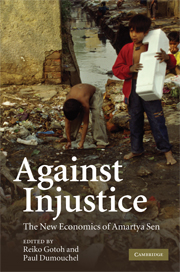Book contents
- Frontmatter
- Contents
- List of figures
- List of tables
- List of contributors
- Acknowledgements
- Introduction
- Part I
- Part II
- 4 The power of a democratic public
- 5 The challenge of gender justice
- 6 Gift, market, and social justice
- 7 Justice and public reciprocity
- 8 Reasoning with preferences?
- 9 Conceptions of individual rights and freedom in welfare economics: a re-examination
- Part III
- 13 Part IV
- Index
- References
9 - Conceptions of individual rights and freedom in welfare economics: a re-examination
Published online by Cambridge University Press: 18 January 2010
- Frontmatter
- Contents
- List of figures
- List of tables
- List of contributors
- Acknowledgements
- Introduction
- Part I
- Part II
- 4 The power of a democratic public
- 5 The challenge of gender justice
- 6 Gift, market, and social justice
- 7 Justice and public reciprocity
- 8 Reasoning with preferences?
- 9 Conceptions of individual rights and freedom in welfare economics: a re-examination
- Part III
- 13 Part IV
- Index
- References
Summary
Introduction
Historically, much of normative economics has been guided by welfarism, i.e. the ethical principle that the welfare evaluation of alternative social policies should be based exclusively on their effects on the utilities of the individuals concerned. Though issues relating to non-utility aspects of social policies such as individual rights, freedom, and fairness are often figured into such welfaristic evaluations, they enter the evaluation process indirectly as instruments affecting the utilities of the individuals involved. Their independent status in assessing social policies is ignored by welfarism. In recent years, however, there has been growing recognition on the part of economists that welfarism constitutes a restrictive framework for normative economics, and that non-utility information, as well as information about individual utilities, must be taken into account independently in the evaluation of social policies. For example, when a certain legislation concerning, say, security, is proposed, the effects on individuals' utilities are certainly legitimate concerns. At the same time, considerations of personal liberty and individual rights to privacy also play an important and independent role in evaluating such legislation.
Among the non-utility concerns that often figure in debates about alternative social policies, two, individual rights and freedom, stand out prominently. Thanks to the pioneering contributions of Sen (1970a; 1970b; 1985; 1987; 1988), both individual rights and freedom have received much attention from welfare economists over the last three decades or so, and several models have been constructed to incorporate them in the formal analysis in welfare economics.
- Type
- Chapter
- Information
- Against InjusticeThe New Economics of Amartya Sen, pp. 187 - 218Publisher: Cambridge University PressPrint publication year: 2009
References
- 2
- Cited by



